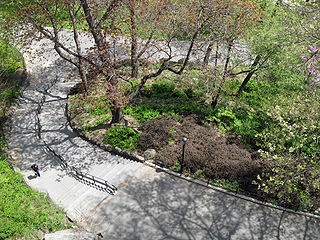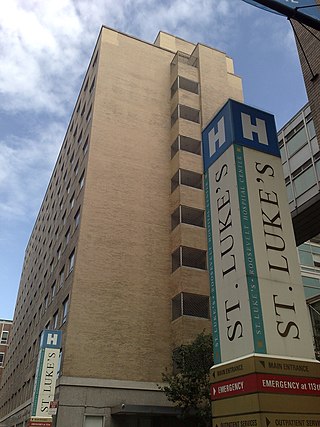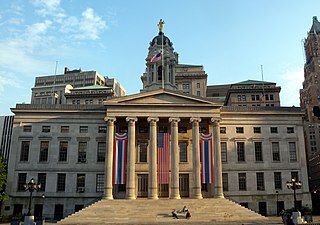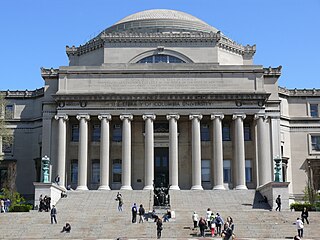
Morningside Heights is a neighborhood on the West Side of Upper Manhattan in New York City. It is bounded by Morningside Drive to the east, 125th Street to the north, 110th Street to the south, and Riverside Drive to the west. Morningside Heights borders Central Harlem and Morningside Park to the east, Manhattanville to the north, the Manhattan Valley section of the Upper West Side to the south, and Riverside Park to the west. Broadway is the neighborhood's main thoroughfare, running north–south.

Morningside Park is a 30-acre (12-hectare) public park in Upper Manhattan, New York City. The park is bounded by 110th Street to the south, 123rd Street to the north, Morningside Avenue to the east, and Morningside Drive to the west. A cliff made of Manhattan schist runs through the park and separates Morningside Heights, above the cliff to the west, from Harlem. The park includes other rock outcroppings; a man-made ornamental pond and waterfall; three sculptures; several athletic fields; playgrounds; and an arboretum. Morningside Park is operated by the New York City Department of Parks and Recreation, although the group Friends of Morningside Park helps maintain it.

Mount Sinai Morningside, formerly known as Mount Sinai St. Luke's, is a teaching hospital located in the Morningside Heights neighborhood of Manhattan in New York City. It is affiliated with the Icahn School of Medicine at Mount Sinai and the Mount Sinai Health System, a nonprofit hospital system formed by the merger of Continuum Health Partners and the Mount Sinai Medical Center in September 2013. It provides general medical and surgical facilities, ambulatory care, and a Level 2 Trauma Center, verified by the American College of Surgeons. From 1978 to 2020, it was affiliated with Mount Sinai West as part of St. Luke's–Roosevelt Hospital Center.

Brooklyn Borough Hall is a building in Downtown Brooklyn, New York City. It was designed by architects Calvin Pollard and Gamaliel King in the Greek Revival style, and constructed of Tuckahoe marble under the supervision of superintendent Stephen Haynes.

The Low Memorial Library is a building at the center of Columbia University's Morningside Heights campus in Upper Manhattan, New York City, New York, United States. The building, located near 116th Street between Broadway and Amsterdam Avenue, was designed by Charles Follen McKim of the firm McKim, Mead & White. The building was constructed between 1895 and 1897 as the university's central library, although it has contained the university's central administrative offices since 1934. Columbia University president Seth Low funded the building with $1 million and named the edifice in memory of his father, Abiel Abbot Low. Low's facade and interior are New York City designated landmarks, and the building is also designated as a National Historic Landmark.

Morningside Drive is a roughly north–south bi-directional street in the Morningside Heights neighborhood of the New York City borough of Manhattan. It runs from 110th Street in the south, where it forms the continuation of Columbus Avenue, to 122nd Street-Seminary Row in the north, which Morningside Drive becomes after turning to the west and crossing over Amsterdam Avenue.

The Central Park West Historic District is located along Central Park West, between 61st and 97th Streets, on the Upper West Side of Manhattan in New York City, United States. The district was added to the National Register of Historic Places on November 9, 1982. The district encompasses a portion of the Upper West Side-Central Park West Historic District as designated by the New York City Landmarks Preservation Commission, and contains a number of prominent New York City designated landmarks, including the Dakota, a National Historic Landmark. The buildings date from the late 19th century to the early 1940s and exhibit a variety of architectural styles. The majority of the district's buildings are of neo-Italian Renaissance style, but Art Deco is a popular theme as well.

George Frederick Pelham was an American architect and the son of George Brown Pelham, who was also an architect.
Charles Alonzo Rich was an American architect who practiced in New York City from 1882 until 1933. Rich was a member of the Architectural League of New York. Rich was a partner in the New York architectural firm of Lamb & Rich, that mostly specialized in residential design.
Schwartz & Gross was a New York City architectural firm active from at least 1901 to 1963, and which designed numerous apartment buildings in the city during the first half of the 20th century. The firm, together with the firm Neville & Bagge and the firm owned by George F. Pelham, accounted for about half the apartment houses in Manhattan's Morningside Heights neighborhood.

The Church of Notre Dame is a parish of the Roman Catholic Archdiocese of New York. The church is located at 40 Morningside Drive and the rectory at 405 West 114th Street in Morningside Heights, Manhattan, New York City. In 2022, the parish merged with nearby Corpus Christi.
Frank Freeman was a Canadian-American architect based in Brooklyn, New York. A leading exponent of the Richardsonian Romanesque architectural style who later adopted Neoclassicism, Freeman has been called "Brooklyn's greatest architect". Many details of his life and work are however still unknown, and Freeman himself has received little recognition outside academia. Many of his works have been demolished or otherwise destroyed, but most of those that remain have received New York City landmark status, either independently or as part of larger historic districts.

The South Village is a largely residential area that is part of the larger Greenwich Village in Lower Manhattan, New York City, directly below Washington Square Park. Known for its immigrant heritage and bohemian history, the architecture of the South Village is primarily tenement-style apartment buildings, indicative of the area's history as an enclave for Italian-American immigrants and working-class residents of New York.

The Bloomingdale Insane Asylum (1821–1889) was an American private hospital for the care of the mentally ill, founded by New York Hospital. It was located in the Morningside Heights neighborhood of Manhattan in New York City, where Columbia University is now located. It relocated to White Plains, New York, as the Payne Whitney Psychiatric Clinic, now known as the "NewYork-Presbyterian Westchester Behavioral Health Center."

The Delta Psi, Alpha Chapter fraternity house is located at 434 Riverside Drive in the Morningside Heights neighborhood of Manhattan, New York City. It was purpose built in 1898 and continues to serve the Columbia chapter of the Fraternity of Delta Psi, a social and literary fraternity.

Casa Italiana is a building at Columbia University located at 1161 Amsterdam Avenue between West 116th and 118th Streets in the Morningside Heights neighborhood of Manhattan, New York City, which houses the university's Italian Academy for Advanced Studies in America. It was built in 1926–27 and was designed by William M. Kendall of McKim, Mead & White in the Renaissance style, modeled after a 15th-century Roman palazzo. The building was restored, and the east facade completed, in 1996 by Buttrick White & Burtis with Italo Rota as associate architect.

Valentine Everit Macy was an American industrialist and philanthropist, involved in local government. In the 1910s and 1920s, he served in Westchester County, New York, as commissioner of the Department of Charities and Corrections, the Commissioner of Public Welfare, and as Commissioner of Parks.
Carolyn Wade Cassady Kent was an American historical preservationist and activist who lived most of her life in New York City on Riverside Drive, one block west of her alma mater Columbia University. As founder of Manhattan Community Board 9's Parks and Landmarks Committee and co-founder of the Morningside Heights Historic District Committee she worked to advocate for the architectures and communities of Morningside Heights, Manhattanville and Hamilton Heights in close collaboration with community, city and state organizations and agencies, to effect landmark designations, restorations and interventions that have preserved and protected buildings and entire neighborhoods. In 2007, she was given the first Preservation Angel Award. In addition, Kent served as Secretary of the Renaissance English Text Society.
Wilfred E. Anthony (1878–1948) was an American architect. A "Gothic specialist", he worked for Cram, Goodhue & Ferguson.















